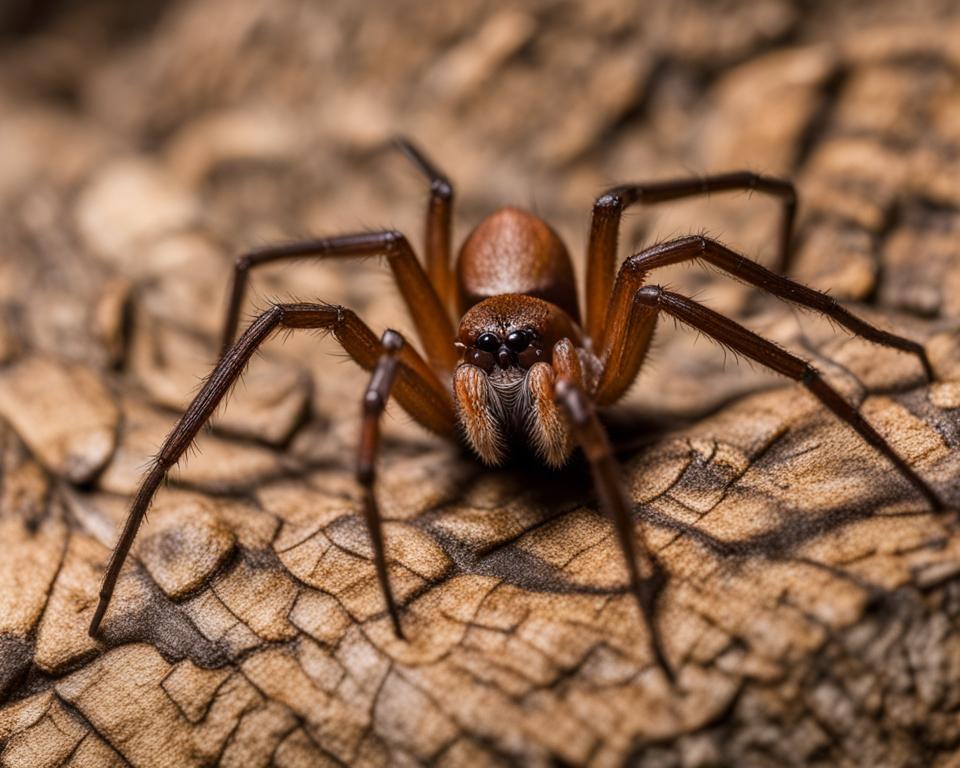If you live in an area where spiders are common, it’s important to be able to differentiate between wolf spiders and brown recluses. While both spiders can be found in the United States, they have distinct characteristics that set them apart.
Knowing how to identify these spiders can help you avoid potential encounters and protect yourself from harmful bites. In this section, we will explore the key differences between wolf spiders and brown recluses to help you with spider identification.
Key Takeaways:
- Wolf spiders and brown recluses have distinct physical characteristics and behavior patterns.
- The venomous nature of brown recluses can cause harm, so it’s important to seek medical attention if bitten.
- Understanding where these spiders are typically found can help you identify potential infestations and take preventative measures.
- Effective pest control methods can help eliminate a spider infestation.
- By familiarizing yourself with the key differences between wolf spiders and brown recluses, you can better protect yourself and your surroundings from these potentially dangerous spiders.
Physical Appearance and Behavior
One of the best ways to differentiate between wolf spiders and brown recluses is by studying their physical appearance and behavior.
Wolf spiders are typically larger than brown recluses, ranging from ¼ inch to 1 ⅜ inches long. They are covered in fur and have distinctive eye patterns, with two large eyes at the front and four smaller eyes below them. Unlike brown recluses, wolf spiders do not spin webs. They are active hunters and rely on their excellent eyesight and agility to catch their prey.
Brown recluses, on the other hand, are smaller and measure around ¼ inch to ½ inch. They have a darker, uniform coloration, with a violin-shaped marking on their head. They spin irregular webs in hidden places such as closets, attics, or basements and wait for their prey to get caught in it.
Fun fact: The name “recluse” refers to their reclusive nature, preferring to live in solitude and only coming out to hunt at night.
Both wolf spiders and brown recluses can be found in different parts of the United States. Wolf spiders live in open fields, forests, and deserts, while brown recluses thrive in warm, humid climates, residing under rocks, logs, or inside homes.
It is important to approach these spiders with caution and avoid handling them, as both can bite if provoked, resulting in itching, swelling, or in some cases, serious health complications.
Venom and Bites
Both brown recluse and wolf spiders are venomous spiders, and their bites can cause significant harm to humans.
The venom of the brown recluse spider contains a cytotoxin that can produce a range of symptoms, including severe pain, fever, and tissue necrosis, which can lead to scarring. Seek medical attention immediately if bitten by a brown recluse.
While wolf spider bites can also be painful, they are generally less serious than brown recluse bites and typically don’t require medical attention. However, if you experience an allergic reaction or severe symptoms, seek medical help immediately.
It’s essential to identify the spider that bit you correctly, as misidentification could lead to misguided treatment and potential complications.

“Brown recluse bites are a medical emergency. If you suspect that you might have been bitten by one, seek medical attention immediately.”
– Centers for Disease Control and Prevention (CDC)
Preventing Spider Bites
To reduce your risk of encountering venomous spiders like the brown recluse and wolf spiders, follow these preventive measures:
- Wear gloves and shoes in areas where spiders may be present
- Keep your home clean and free of clutter
- Seal cracks and gaps in your home to prevent spiders from entering
- Consult with a pest control professional to treat active infestations and establish preventative measures
Distribution and Habitat
Knowing where wolf spiders and brown recluses are commonly found is crucial for preventing spider infestations. Both species have distinct distribution and habitat preferences.
Wolf Spiders
Wolf spiders are commonly found throughout the United States, including forests, fields, and grasslands. They also frequently inhabit gardens, crawl spaces, and under rocks or debris. These spiders prefer dry climates and are often seen indoors during the cooler months of the year, seeking warmth.
Brown Recluses
Brown recluses are primarily found in the central and southern regions of the United States. They tend to inhabit warm, dry environments such as attics, basements, and storage sheds. Brown recluses are often found in cluttered areas with many potential hiding places, such as piles of clothing or boxes.

Spider Infestation
If you suspect a spider infestation in your home or property, it is important to take action immediately. Contacting a pest control professional can help identify the extent of the infestation and provide effective solutions for exterminating the spiders.
Pest Control and Extermination
If you’ve spotted a wolf spider or brown recluse in your home or workplace, it’s critical to take action immediately, especially if you live in an area where these spiders are prevalent. Here are some effective strategies for controlling and exterminating these dangerous spiders:
Preventative Measures
To prevent spider infestations, clean and declutter your living or working spaces regularly. Keep your home or office free of piles of boxes, papers, and dirty laundry. Seal any cracks, holes, or gaps in your doors, windows, and walls to eliminate points of entry. Use airtight containers for storing food and discard any expired items promptly. Outside, keep your lawn mowed and eliminate any standing water sources, such as pet bowls or flowerpots, to avoid attracting spiders.
Safe Removal Methods
If you’ve found a wolf spider or brown recluse, avoid handling it directly. Instead, utilize spider traps, sticky papers, or vacuuming to capture or eliminate the spider. Remember to seal and dispose of the vacuum bag or container promptly after use. If you are unsure how to remove the spider safely, consider hiring a professional spider control service.
Professional Extermination
If you’re facing a severe spider infestation, such as multiple sightings of brown recluses or wolf spiders, professional extermination may be necessary. A trained pest control professional can conduct an inspection, identify the extent of the infestation, and treat the area safely and effectively to eliminate the spiders.
Conclusion
Now that you are aware of the key differences between wolf spiders and brown recluses, you can handle encounters with these dangerous spiders with greater confidence. Remember to always be cautious when in spider-prone areas, such as basements, garages, and woodpiles.
If you suspect a spider infestation, consider seeking professional pest control services to ensure effective and safe removal. Additionally, if you are bitten by either spider, seek medical attention immediately to avoid potentially severe consequences.
By implementing preventive measures and staying informed about spider identification and control, you can keep yourself, your family, and your surroundings safe from the dangers of wolf spiders and brown recluses.
Stay vigilant and stay safe!
FAQ
What are the key differences between wolf spiders and brown recluses?
Wolf spiders and brown recluses differ in their physical appearance, behavior, and venomous nature. Wolf spiders are generally larger, hairy, and have prominent eyes, while brown recluses are smaller, brown in color, and have a characteristic violin-shaped marking on their bodies. Wolf spiders are non-aggressive and do not typically bite humans unless provoked, while brown recluses can bite when threatened and their bites can cause severe symptoms. It’s important to accurately identify these spiders to take appropriate action if encountered.
How can I distinguish between a wolf spider and a brown recluse?
To differentiate between a wolf spider and a brown recluse, look for the following characteristics. Wolf spiders are typically larger, measuring about 1 to 2 inches in size, have a robust body covered in hair, and possess distinctive large eyes that shine in light. Brown recluses are smaller, usually around 0.25 to 0.5 inches, and have a violin-shaped marking on their backs. Their bodies are light to dark brown. If you’re unsure, it’s always best to consult with a professional for proper spider identification.
Are wolf spider bites dangerous?
In general, wolf spider bites are not considered dangerous to humans. While their bites may cause some discomfort, pain, and minor swelling, they rarely result in serious medical complications. However, individuals with allergies or those who experience severe symptoms after a wolf spider bite should seek medical attention.
Are all brown recluse spider bites venomous?
Yes, all brown recluse spider bites are venomous. Brown recluses possess a potent venom that can cause necrotic skin lesions, known as necrotic arachnidism. Not everyone who is bitten by a brown recluse will develop necrotic lesions, but it’s important to be cautious and seek medical attention if bitten, especially if symptoms such as intense pain, redness, or ulcer formation occur.
How can I prevent a spider infestation in my home?
To prevent spider infestations, keep your home clean and clutter-free, as spiders are attracted to dark and quiet corners. Regularly vacuum and dust, seal cracks and crevices, install screens on windows and doors, and remove any potential food sources for spiders, such as insects or other pests. If you suspect an infestation, contact a professional pest control service for effective spider control measures.
How can I safely remove a wolf spider or a brown recluse from my home?
It is recommended to contact a professional pest control service for the safe removal of wolf spiders and brown recluses. These experts have the necessary knowledge, tools, and pesticides to effectively eliminate spiders and reduce the risk of bites or infestations. Attempting to remove venomous spiders yourself can be risky and may result in bites or increased spider activity.
